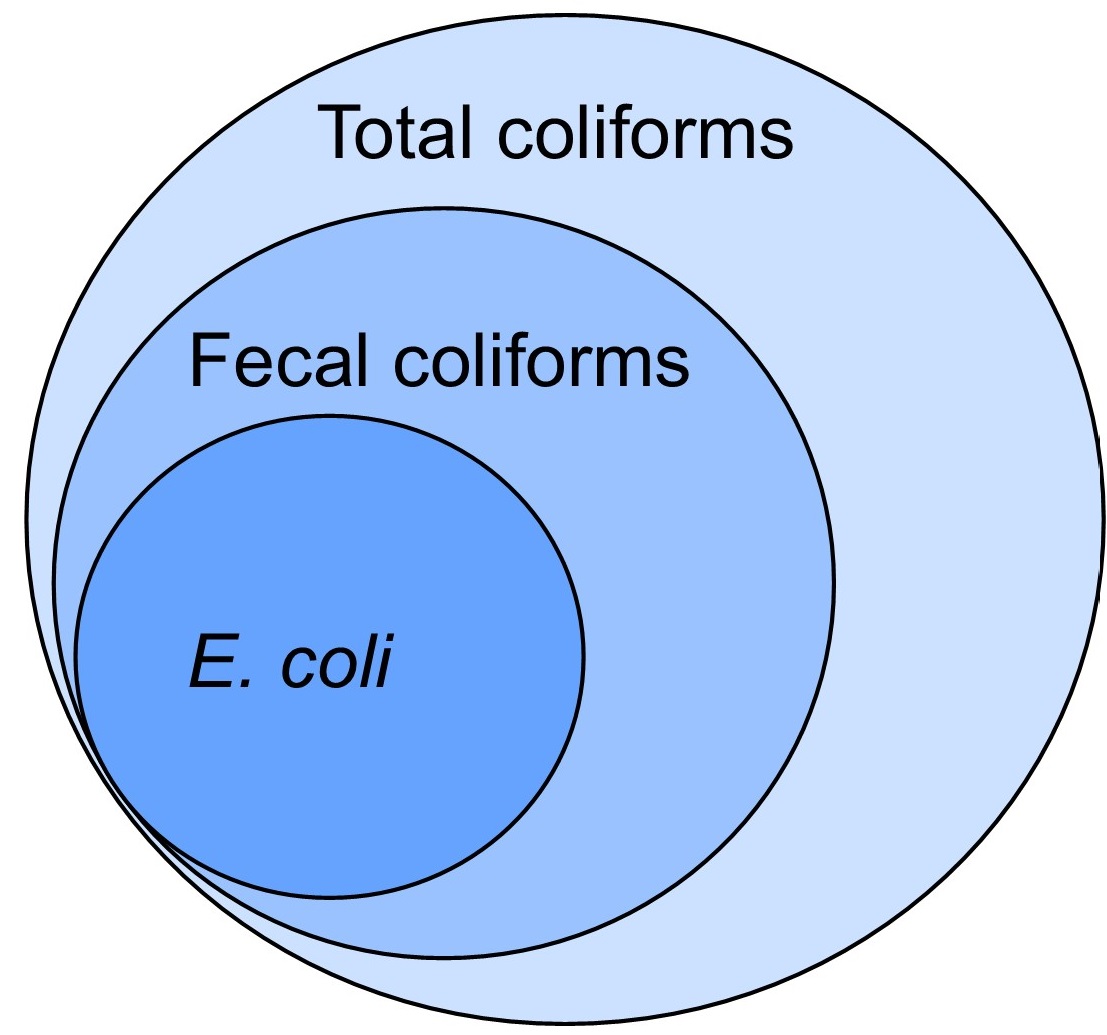DHHS → MeCDC → Environmental and Community Health → Drinking Water → Compliance & Enforcement →
Regulated Contaminants → Total Coliform
Total Coliform
What is Total Coliform?
Coliforms are a large group of bacteria that are present throughout the environment. They are in the soil, on plants, and in surface waters. Certain coliforms, called fecal coliform, live in the guts and waste of animals and humans. Escherichia coli or E. coli is a specific species of coliform bacteria. E. coli is a concern because some types of E. coli can cause illness in humans.

Total coliforms are present throughout the environment. They are found in soil, water, and human or animal waste.
Fecal coliforms are a group of bacteria within the total coliforms and are present in the gut and waste of warm-blooded animals.
E. coli is a specific species of fecal coliform bacteria. It is the best indicator of fecal pollution. Only rare strains of E. coli can cause serious illness.
Total coliforms are used as an 'indicator' for testing drinking water quality. Generally, these bacteria are not harmful. However, when present, total coliform bacteria are an indication that disease causing microorganisms such as E. coli, other bacteria, viruses, and parasites may have entered the water supply or system. Because it would be difficult, if not impossible, to test for every disease-causing microorganism, coliforms are used as an indicator of organisms; if coliforms are present, there is a chance harmful organisms are also present.
What is the Maximum Contaminant Level (MCL) for Total Coliform?
The Environmental Protection Agency (EPA) establishes health standards for contaminants in drinking water. The heath standard for total coliform in drinking water established by the Environmental Protection Agency (EPA) is zero. Water systems are required to take samples for total coliforms based on the population served, source type, and vulnerability to contamination. No more than 5% of samples for total coliforms can be positive in one month. (For systems that collect fewer than 40 routine samples per month, no more than one sample can be total coliform-positive per month.) If a sample tests positive for total coliforms, the system must collect a set of repeat samples within 24 hours, and analyze for E. coli. To learn more about the testing requirements visit our webpage dedicated to the Revised Total Coliform Rule.
A maximum contaminant level (MCL) is the highest level of a contaminant that is allowed in drinking water. MCLs are set as close to the maximum contaminant level goals (MCLG) as feasible using the best available treatment technology. MCLG is the level of contaminant in drinking water below which there is no known or expected risk to health.
What are the Health Effects of Total Coliform?
Total coliforms do not pose risks to human health. They are used to indicate whether other potentially harmful bacteria may be present. Fecal coliform and E. coli are bacteria, that when present, indicate that water may be contaminated by human or animal wastes. Some species of E. coli may result in illness, including diarrhea, cramps, nausea, headaches, or other symptoms. Children under five years of age, those with compromised immune systems, and the elderly are particularly susceptible to illness.
A fact sheet with information on E. coli in drinking water can be found here:
What is the Revised Total Coliform Rule (RTCR)?
The RTCR is a change to the EPA’s 1989 Total Coliform Rule and was enacted to provide greater public health protection. The revised rule establishes a maximum contaminant level (MCL) for E. coli and uses E. coli and total coliforms to initiate a "find and fix" approach to address potential fecal contamination of the distribution system. It requires public water systems to perform assessments to identify sanitary defects and take corrective action. You can learn more about the RTCR on this page of our website: RTCR webpage.
Additional Resources
- Frequently Asked Questions about Coliform bacteria and Boil Water Orders
- Total Coliform Rule: A Quick Reference Guide (pdf, U.S. EPA)
- Drinking Water Orders
- Water Sampling Instructions- Total Coliform Bacteria (PDF)
- Sampling
- Maine Certified Commercial Laboratories (PDF)
- Well Shocking Fact Sheet (PDF)
- Disinfecting Pipes and Tanks (PDF)
- Protecting Public Health During Chlorination Disinfection System Failures (PDF)
- Protecting Public Health During UV Disinfection System Failures (PDF)
- Groundwater Rule


